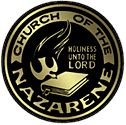Christmas Today
Christmas in church
Advent is the period of preparation for the celebration of the birth of Jesus and begins on Sunday nearest to 30th November. The word Advent comes from the Latin adventus meaning coming. Traditionally it is a penitential season but is no longer kept with the strictness of Lent and Christians are no longer required to fast.
Advent wreaths are popular especially in churches. They are made with fir branches and four candles. A candle is lit each Sunday during Advent.
Christmas Day is the Christian festival most celebrated by non-churchgoers, and churches are often completely full for the service late on Christmas Eve.
Father Christmas 
An important part of today's Christmas is the myth of Father Christmas (called Santa Claus in America). His origins are in Christian and European tradition. But the visual image of Father Christmas that we have today is the one popularised by American card-makers in the Victorian era. Traditionally, Father Christmas visits houses at midnight on Christmas Eve, coming down the chimney to leave presents. Children hang up stockings - nowadays usually large socks with Christmas patterns knitted into them - for Father Christmas to fill with little toys and presents ('stocking fillers'). Some traditions surrounding Father Christmas pre-date Christianity. His sleigh, pulled by reindeer, is left over from Scandinavian mythology. The practice of leaving mince pies and a glass of milk or brandy for him on Christmas Eve may be a remnant of Pagan sacrifices made to mark the end of winter and the coming of spring.
The USA has the figure of Santa Claus, whose name comes from Saint Nicholas via the Dutch Sinterklaas. Saint Nicholas of Myra (a location in modern-day Turkey) is, among other things, the patron saint of sailors. A famous story has him anonymously delivering bags of gold coins to a man who could not afford dowry for his daughters to get married. Some versions of this story even have Saint Nick dropping the bags down the chimney.
In modern times the figures of Father Christmas and Santa Claus are indistinguishable.
Christmas today
Today, only around 60 percent of people in the UK are Christian but Christmas remains the biggest holiday in the calendar. It is a largely secular holiday, with the main element the exchange of gifts on Christmas day. In previous centuries the Church worried about Pagan influence on the Christian festival, but today ethical considerations are focused on the over-commercialism of the holiday with each person in the UK spending on average £400 on Christmas related purchases.
In previous centuries the Church worried about Pagan influence on the Christian festival, but today ethical considerations are focused on the over-commercialism of the holiday with each person in the UK spending on average £400 on Christmas related purchases.
Protests against consumerism have been made by Christians and non-Christians such as 'Buy Nothing Christmas', encouraging people to spend time with their families instead of spending money on them.
With carol concerts, Christmas trees, office parties, midnight mass, and television programmes, today's festival has elements of the Pagan, Christian and folk traditions.
Christmas remains a time to forget about the long dark days and celebrate with friends and family.

